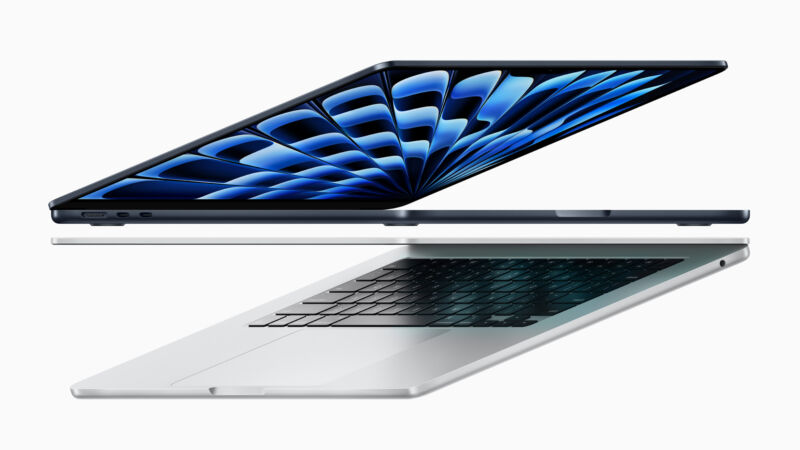M2 Air is the new $999 base model, M1 Air goes away after more than 3 years.

Apple has quietly refreshed its MacBook Air lineup, bringing new chips (and in some cases, new prices) to its most popular laptops. New 13- and 15-inch MacBook Airs include Apple’s latest-generation M3 chip, while the old M2 MacBook Air now replaces 2020’s M1 MacBook Air as Apple’s $999 entry-level laptop. The new 13- and 15-inch M3 systems start at $1,099 and $1,299; they can be ordered today and will be released on March 8.
The new Airs use the same design as the M2 versions. Compared to older M1 and late-Intel-era Airs, they have slightly larger displays with a prominent notch, a non-tapered but still thin-and-light chassis, larger trackpads, modestly refined keyboards, and a MagSafe port for charging.
Apple overhauls MacBook Pro lineup with M3 chips and a new entry-level option
All of the new Airs use the M3, with no options to upgrade to faster or more capable processors (this means the Air is still restricted to just a single external display when the built-in display is on, though the M3 can now drive two external displays when the lid is closed, something older chips didn’t offer). The $1,099 13-inch Air does use a slightly cut-down version of the chip with 8 GPU cores instead of 10, with the 10-core GPU available as a $100 upgrade; all 15-inch models use the fully enabled M3 with the 10-core GPU.
Aside from the M3 chip, the new laptops also support Wi-Fi 6E, and hardware-accelerated video decoding for the AV1 video codec. But other specs, including RAM and storage options, stay the same as before. Both laptops start with 8GB and 256GB of RAM and storage, respectively, and top out at 24GB and 2TB. Both Airs’ performance should generally be similar to the 14-inch M3 MacBook Pro that starts at $1,599, though the Pro has a cooling fan that may help it run heavy workloads a bit more quickly.Advertisement
All versions of the M3 include four high-performance CPU cores and four high-efficiency CPU cores, the same as the M1 and M2, though Apple says that chip upgrades have made the M3 “up to 60 percent faster” than the M1. Performance upgrades compared to the M2 will be a bit milder.
The update gets the 13- and 15-inch Airs onto the same update schedule, though the timing is a bit awkward for the barely nine-month-old 15-inch M2 MacBook Air. That’s an even shorter life cycle than we saw with the M2 MacBook Pros that Apple replaced last November after just 11 months. But the 13-inch M2 MacBook Air originally came out in July of 2022 and was well overdue for an upgrade.
The only Macs without an M3 update are Apple’s desktops: the Mac mini, the Mac Studio, and the Mac Pro. Of these, the M2 Mac mini is the oldest, and Apple has already released the M3 and M3 Pro chips that would probably be used in a refresh. It’s possible that Apple is waiting to get the mini and the Studio models in sync with one another to prevent some of the awkward overlap that happened last year when the Mac mini got an M2 upgrade but the Studio still used M1 chips.




